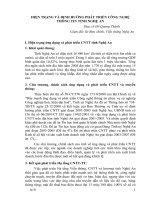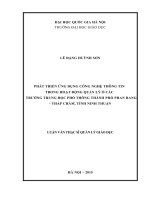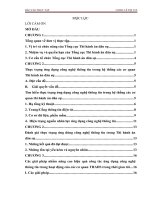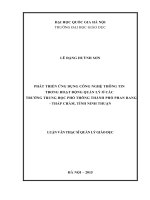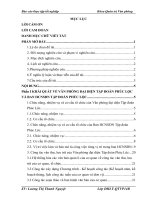HIỆN TRẠNG và ĐỊNH HƯỚNG ỨNG DỤNG CÔNG NGHỆ THÔNG TIN TRONG LĨNH vực QUẢN lý đất ĐAI e
Bạn đang xem bản rút gọn của tài liệu. Xem và tải ngay bản đầy đủ của tài liệu tại đây (402.44 KB, 11 trang )
THE SITUATION AND ORIENTATION OF APPLYING INFORMATION
TECHNOLOGY IN THE FIELD OF LAND MANAGEMENT
Foreword
The application of information technology(IT)is one of the important directions of
Natural Resources and Environment in the current period. The application of IT is
required to meet the objectives of state management about the natural resources and
environment in sustainable development and the implementation of the policy of
economic sectors. In the field of state management of natural resources and the
environment, the application of IT in the field of land management has made certain
achievements, however there are many inadequate points, that need to have a longterm strategy with specific objectives and methods to get a database with modern land
model, smoothly from the central to the local level and it is one of the management
tools of the sector.
This paper deeply analyzed the current state of the application of IT from the previous
period to the current one, including the factors to invest infrastructure, information,
technology, software technology, human resources, the situation of existing data and
policies on IT development. On the basis of analyzing the existing status, the paper
also proposes some specific strategies and solutions suitable with the development of
technology-oriented, to promote and elevate the use of IT in the field of land
management to a new level.
To make the application of IT in general and the development of databases on land, to
achieve the above objectives, it requires to have the research with firmly scientific
rationale, the investment resources and awareness on the application of IT from the
leadership to managers at all levels. The discussion with yourself-limited only
proposed strategic directions and some specific solutions, subsequent studies as well
as the implementation of the project has been and will be made the basis to achieve
the objectives of the field.
1
1. The current situation of applying IT in land management
The application of IT in land management may be ranged from about 1994 to present,
with the application areas from State management agencies central to the local ones.
On the current situation, it can be analyzed by the way of : policy and implementation
mechanisms, organizational structure and human resources, technologies and
investment status.
About the policies and implementation mechanisms
The application of IT in the field of natural resources and environment in general and
land management in particular before 2004, does not have the legal basis. The plans
applying IT for the field of land management before 1994, also had some funds from
the central budget, non-refundable ODA capital and some provinces and cities with
budget local.
In 2004, the Prime Minister signed the decision 179/2004/QD-TTg on approving the
application strategy and development of IT, resources and the environment to 2015
and orientations towards 2020 (after referred to as Decision 179). In the decision
179,it gave four major objectives and 7 key tasks. The database construction of
resources and the environment in general and land ones in particular is one of the most
basic tasks.
After five years of implementing the strategy by Ministry of Natural Resources and
Environment, there have been changes in the context. In the field of IT, the law of IT
2007 was adopted at the 7th and the 8th session of the XI National Assembly, they are
important legal documents ,institutionalized the 58 th of the Directive politics. On
10/4/2007 ,the Government issued Decree No. 64/2007/ND-CP on the application of
IT in the operation of state agencies (Decree 64). Decree specifies the content, tasks
and implementation of the IT application in the operation of state agencies and
determines the responsibility of the heads of agencies and units in the branches and
localities.
To promote and implement a consistent strategy, to promote the application of IT in
the field of Natural Resources and Environment, the Minister of Natural Resources
2
and Environment also had the Decision 1888/QD-BTNMT on 9/29/2008 about the
establishment of the Steering Committee for implementing the strategy:”The
application and development of IT resources and environment up to 2015 and
orientations to 2020 (the Steering Committee for short), the Standing Deputy Nguyen
Van Duc is the chief, The General Department of Land Management also has
members in the Steering Committee ,and participate in the activities of the Steering
Committee in the field of IT applications, in the field of land management, which is
consistent with the general direction.
Ministry
of
Natural
Resources
and
Environment
has
submitted
to
the
Government,issueing the Decree 102/2008/ND-CP on the collection, management,
exploitation and the use of natural resources and environment database, issued on
09/15/ 2008,in which provides detailed data list of land management and builds a
database of natural resources and environment at all levels and sectors. Subsequently,
the Ministry of Natural Resources and Environment has promulgated a circular
07/2009/TT-BTNMT July 10, 2009 on detailing a number articles of Decree No.
102/2008/ND-CP.It provides more details on the functions of the unit of collecting,
managing and giving datas.
The General Department of Land Management has developed and implemented the
project "Construction and Test Preparation of cadastral data in Vietnam" with the goal
of building and imposing the standard cadastral data for Viet Nam . Vietnam cadastral
data standards will be applied directly to build the cadastral database ,to serve the
needs of land management;to exchange the cadastral database between the land
management’s level;to provide one for the needs and the community in general.
Vietnam cadastral data standard is based on the guidance of the geographic
information standard national basis by the Ministry of Natural Resources and
Environmental Affairs and the international geographic information standards ISO
19100. Accordingly, the cadastral data standard must include provisions to
standardize: the cadastral data contents, structure model of cadastral data, the
coordinate reference for cadastral data, metadata for applying cadastral data, data
3
quality requirements for cadastral, cadastral data presentation and the exchange,
cadastral data distribution.
The state policy on land management is also in the process of finishing, the process of
implementation, the report sample, the certificate of land use sample has been changed
too much in the short time, leading to the application of IT having a lot of
shortcomings,the editing of system put to use in a very short time, lack of funding is
very popular.
While there were a number of legal documents, certain policies in the IT application
about the land management ,but the text system is still missing a lots from the
beginning, implementing, acceptance testing, technical regulations, products
delivering, technical and economic norms and so on… ,be able to get a policy
framework as a basis for implementation.
Organizational structure and human resources
For the implementation of Decision 179 and the legal documents on the IT application
for Natural Resources and Environment in general ,Land Management in particular,
the central to local level have organised the units, responsible for IT application and
the development of land databases.
Towards to the central agency, the General Department of Land Management has
established the Center for Information Storage and land as units under the General
Department (in Decision No. 18/QD-TCQLDD on November,07 th ,2008 of the
General Director of the General Department of Land Management, defining the
functions, tasks, powers and organizational structure of the Center for Information
Storage and land). The center has functions to build and manage the land database of
the central level . To the Ministry of Natural Resources and Environment, the
Department of IT has the function of state management about the IT applications,
proposes policies and technical regulations, supervies the test and the implementation
for this work.
4
The system of office about the land use right registration, the system of storage
information center, the Center for IT are available to make the application of IT and
build the land database at the local-level.
The problem existing in the organizational structure is the overlap, is not really clear
about the function of managing and providing land datas in the units, about the human
resources, about capital investment for the IT application projects. There is no really
close connection between the projects (with basic surveys) with the construction of
the database, no exchange model,no reports about the land information database
between the administrative units and the subordinate administrative unit and directly
upper ones.
In some localities, after the hosted information center delivers the documents,
cadastral data for land use right registration office, the datas and documents are still
less, mainly land documents land,it leads to the inefficient activities of the storage
information center. On the other hand, the land use right registration office is not
enough manpower in IT, the task of building the database of local level still has some
problems.It does not have a uniform guidelines for the organization of the land
building database for any unit, so this work is done very different, depending on the
locality.
Human resources of IT at the Department of Natural Resources and Environment is
also very different and dispersed in different units, so after transfering , many units
just do as the test level but not do in large-scale deployment, they do not put the
database, going to land management processes actually and support the policy
decisions.
Technologies and investment situation.
It builds the land database associated with the geographic information systems
technology (GIS) and CAD applications to digitize the cadastral data. Through the
study of different units, the projects have been implemented from 1992 onwards,
many technologies have been applied in the state management centers about the land
from the central to the local level, the businesses of cartography and cadastral records.
5
The basic application technology is the advanced technology in Vietnam and over the
world.
Nowadays,it has a lot of land information systems due to various units within and
outside the construction firm. It can list some typical systems such as ELIS
(Department of Information Technology), ViLIS (National Remote Sensing Center),
EKLIS (EK Company) and many other companies.
The used GIS technologies are also very diverse background as ESRI's ArGIS (U.S.),
MapInfo, AutoCAD and some other manufacturers. Database management system
using Oracle, SQL Server, Access, etc.. There also have some studies, which apply all
open source applications in LIS construction to save the investment costs for the
technology.
Although there are many products, many applications and units, but the application of
technologies in building land databases still has some shortcomings such as:
continuous change management policy, and result as the change of software with the
lack of fund to update, there is no unit technical standards, there are also many
differences in demand management for each area, the lack of technical support from
the technology provider (typically from overseas) and land information systems
development, due to the lack of human resources and financial policy, there are
concerns about selecting software products for each local and other issues ...
About the management policies, Vietnam is still in the stage of finalizing, the policy
on land management, processes, systems management, statistical reporting forms and
form of certificates of land use rights ... change much in the short term,so the software
must be constantly updated to match the new policy. However, the lack of investment
in long-term strategy ,leads to the backwardness of business processes as using, even
in some places,they can not be used ,it leads to waste huge fees.
The suppliers of the software as well as software applications still lack the
professional and have many different needs of each management area, and the result is
resulted that many construction projects, the development units have to send officials
to present at the local for a long time ,for the use and fixing the system together.
6
Even in the same province, but the decentralization of land management data, result is
that: in a province,it can be applied to many different software solutions, due to the
lack of unit standards (currently, the General Manager land is being submitted to the
Ministry of Natural Resources and Environment issued the Circular on standard
techniques of cadastral data) ,it leads to the difficulty in the integration of data.
The land database has been invested over the period, many projects with many
different sources, but in many localities, they do not match the cadastral mapping, the
initial registration documents with the process of updating land changes, it makes that
the cadastral map is mapped during previous, takes much fees but outdated so the use
value is limited.
One of the programs, the typical project is a cooperation program between Vietnam –
Swedish, about the innovation of cadastral system - CPLAR. This program includes
the non-refundable capital by the international development agency SIDA Swedishsponsored to the General Land Administration from 1997 to 2003. The program is
divided into several policy projects, increasing capacity – the 5 th parts is about the
development and application of land information system (LIS) at the provincial level
and tested in a number of provinces ... The result of this project is to raise
awareness,to transfer technology of digital cadastral mapping, database building on
land registration and management in land use right certificates by technology
,replacing for handwritten ago. The results of the project, not only is in the province
but also is extended to test many other provinces which not be in the scope of the
program. Many provinces have the awareness, use the different resources to build
information systems land at different levels (commune , district area, etc.).
The project of completing and modernizeting land administration system of Vietnam
(VLAP) with a capital of 100 million U.S. dollars from the World Bank's ODA has
been started by the Ministry of Natural Resources and Environment official on
september, 18th in Hanoi. VLAP which is project in Vietnam, about the field of land
management, is studied for over 10 years through the cooperation of many countries,
such as France, Sweden, New Zealand, Finland. Pre-launch projects in nine provinces,
three provinces in the Mekong Delta (Tien Giang, Ben Tre, Vinh Long), three central
7
coastal provinces (Binh Dinh, Khanh Hoa, Quang Ngai) and three Red River Delta
provinces (Hanoi, Hung Yen and Thai Binh). The goal of the project is to increase the
access of all subjects with land information services, by developing a complete system
of land management at the local level through the development of cadastral systems
and digital cadastral map. The project consists of 100 different activities with the three
stages of development in the next five years. The first phase, with the aim of
modernizing the land registration system. Phase 2 will increase land registration
services. Phase 3, supports the management, and monitors the quality of the project’s
results
2.
The
proposed
application-oriented
information
technology
in
land
management.
On the basis of the above analysis about the current situation, to make the application
of IT in land management, it is necessary to perform the synchronization solutions,
including: Building the institution and policy, training human resource, making the
plan of capital investment.
8
The methods of building Institution and policy are grouped into the ones about
standards, procedures, technical regulations, the provisions of the organizational
structure of the unit is responsible for land to build database levels specified group
policy updated, shared, and land use information, the regulations on the legality of the
land database and modernization of administrative procedures on land ,the group of
policies ,strengthening the capacity of agencies ,building and updating the database of
land.
The solutions about the standards, processes, technical regulations need to build the
land management data model at all levels, architecture about land information system
under decentralized management model suitable in Vietnam particular, the standard
cadastral data management at central and local level, the reporting mode,
synchronization and data exchange between databases at all levels, from provincial to
central level. These policies need to be close coordination between the General
Department of Land Management and Department of Information.
Technology under the general direction of the Ministry.
The provisions of the units’s organizational structure is responsible for building land
databases at all levels,it should clearly define the responsibilities and powers of the
unit as the land use right registration office, the Center land development, Technical
Center, the Center for IT in the construction and maintenance of land database.
Together with the functions and tasks, it needs to have regulations on staffing,
capacity requirements for the unit leader on the application of IT, human resources
policies, the policy of attracting human resources to operate and maintain the systems.
The rules on the legality of the land’s database need to be developed to overcome the
situation of building land’s database for reference only, not being valuable in civil
transactions, state’s management , it makes the current database of land in the local
which is better to print the reports, books and certificates of land use rights. It should
be attached the mapping process, the initial registration and certification of land use
rights with the development and the revision of land database ’s changes.
9
The mechanisms, policies and specific regulations about the training of human
resources include: Raising awareness about the IT application for leaders at all levels,
training staffs about system administration, training the management of land
information systems (network, database management and large spin value of land
information system software), the policies of attracting IT human resources working
in units through mechanisms of personel and remuneration of matter and spirit.
The policies of strengthening for land management agencies at all levels should focus
on building the infrastructure of IT (IT equipment, data communication networks at all
levels from social , district, provincial and national), reforming the state administrative
offices, equipping the original software and land information’s systems having rights.
The software solutions for land information system (LIS) need to socialize, allow the
units,businesses to participate in the market providing software solutions of land
information systems and the platform software solutions. However, it must be suitable
with the requirements of state management including policy compliance, the
characteristics of the applied areas and the ability of using officials in the area. The
responding and compatible with the cadastral data is a prerequisite to the application
in the firm. With this orientation,it does not have any units exclusively in the field of
providing solutions to the units used (from district to provincial level). This thing
solves the problem of supporting capacity of units providing solutions and creating
equality in the market mechanism.
About the investment capital, it needs to diversify the types of capital, from the budget
including: investments for initial investment projects, to the economic business capital
for updating and revising land changes (as stipulated in Decree No. 102/2009/ND-CP
of the Government about the management of investing IT applications- using the state
budget), the ODA projects (as SEMLA, VLAP) and socialized on the basis of land
information provided in Vietnam's digital content market-the orientation of state.
The above directions should be legal on the basis of developing IT application in land
management suitable with the direction of the Ministry of Natural Resources and
Environment, the coordination between the central level (the General Department of
Land Management and Department of Information Technology occupies an important
role), the locals (land use right registration office and IT Center under the Department
10
of Natural Resources and Environment). In particular, the attention of the leaders on
the plan and use the funds as analyzed helps the construction of the land database.
Conclusion
The IT application in general and the land database construction in the inter-level,
achieve the goal to 2015, most of the locals have the land’s database connecting
direcetly to the databases of the central and provincial level,issue the land use right ecertificates, continuity and legal values to the database of state agencies and the social
and economic institutions such as the national database on population, business,
banking, insurance, real estate market development is an important task of the land
management sector.
To achieve that goal, it is necessary to have the solution, synchronization mechanism,
effectiveness and focused investment with diversify-orientitation, the socialized
capitals,human resource development with the capacity management, and operating
system.
This address would contribute some of the original ideas, we hope to receive your
suggestions for land management firm ,to achieve the above mentioned objectives.
11
